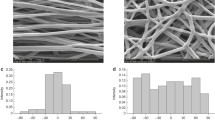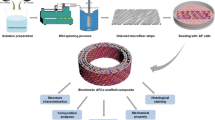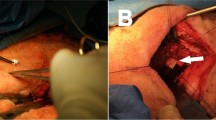Abstract
There is no optimal treatment for symptomatic degenerative disc disease which affects millions of people worldwide. One novel approach would be to form a patch or tissue replacement to repair the annulus fibrosus (AF) through which the NP herniates. As the optimal scaffold for this has not been defined the purpose of this study was to determine if porous silk scaffolds would support AF cell attachment and extracellular matrix accumulation and whether chemically decorating the scaffold with RGD peptide, which has been shown to enhance attachment for other cell types, would further improve AF cell attachment and tissue formation. Annulus fibrosus cells were isolated from bovine caudal discs and seeded into porous silk scaffolds. The percent cell attachment was quantified and the cell morphology and distribution within the scaffold was evaluated using scanning electron microscopy. The cell-seeded scaffolds were grown for up to 8 weeks and evaluated for gene expression, histological appearance and matrix accumulation. AF cells attach to porous silk scaffolds, proliferate and synthesize and accumulate extracellular matrix as demonstrated biochemically and histologically. Coupling the silk scaffold with RGD-peptides did not enhance cell attachment nor tissue formation but did affect cell morphology. As well, the cells had higher levels of type II collagen and aggrecan gene expression when compared to cells grown on the non-modified scaffold, a feature more in keeping with cells of the inner annulus. Porous silk is an appropriate scaffold on which to grow AF cells. Coupling RGD peptide to the scaffold appears to influence AF cell phenotype suggesting that it may be possible to select an appropriate scaffold that favours inner annulus versus outer annulus differentiation which will be important for tissue engineering an intervertebral disc.







Similar content being viewed by others
References
Adams MA, Roughley PJ (2006) What is intervertebral disc degeneration, and what causes it? Spine 31(18):2151–2161
Alini M, Li W, Markovic P, Aebi M, Spiro RC, Roughley PJ (2003) The potential and limitations of a cell-seeded collagen/hyaluronan scaffold to engineer an intervertebral disc-like matrix. Spine 28(5):446–454
Altman GH, Diaz F, Jakuba C, Calabro T, Horan RL, Chen J et al (2003) Silk-based biomaterials. Biomaterials 24(3):401–416
Anderson DG, Tannoury C (2005) Molecular pathogenic factors in symptomatic disc degeneration. Spine J 5(6 Suppl):S260–S266
Baer AE, Wang JY, Kraus VB, Setton LA (2001) Collagen gene expression and mechanical properties of intervertebral disc cell-alginate cultures. J Orthop Res 19(1):2–10
Battie MC, Videman T (2006) Lumbar disc degeneration: epidemiology and genetics. J Bone Joint Surg Am 88(Suppl 2):3–9
Bogduk N (1997) The inter-body joints and the intervertebral discs. In: Bogduk N (ed) Clinical anatomy of the lumbar spine and sacrum. Churchill Livingstone, New York, pp 13–31
Broberg KB (1983) On the mechanical behaviour of intervertebral discs. Spine 8(2):151–165
Carman CV, Springer TA (2003) Integrin avidity regulation: are changes in affinity and conformation underemphasized? Curr Opin Cell Biol 15(5):547–556
Chen J, Altman GH, Karageorgiou V, Horan R, Collette A, Volloch V et al (2003) Human bone marrow stromal cell and ligament fibroblast responses on RGD-modified silk fibers. J Biomed Mater Res A 67(2):559–570
Gruber HE, Leslie K, Ingram J, Norton HJ, Hanley EN (2004) Cell-based tissue engineering for the intervertebral disc: in vitro studies of human disc cell gene expression and matrix production within selected cell carriers. Spine J 4(1):44–55
Hayes AJ, Benjamin M, Ralphs JR (1999) Role of actin stress fibres in the development of the intervertebral disc: cytoskeletal control of extracellular matrix assembly. Dev Dyn 215(3):179–189
Hayes AJ, Benjamin M, Ralphs JR (2001) Extracellular matrix in development of the intervertebral disc. Matrix Biol 20(2):107–121
Horan RL, Antle K, Collette AL, Wang Y, Huang J, Moreau JE et al (2005) In vitro degradation of silk fibroin. Biomaterials 26(17):3385–3393
Hynes RO (2002) Integrins: bidirectional, allosteric signaling machines. Cell 110(6):673–687
Iatridis JC, Maclean JJ, Roughley PJ, Alini M (2006) Effects of mechanical loading on intervertebral disc metabolism in vivo. J Bone Joint Surg Am 88(Suppl 2):41–46
Iatridis JC, MaClean JJ, Ryan DA (2005) Mechanical damage to the intervertebral disc annulus fibrosus subjected to tensile loading. J Biomech 38(3):557–565
Kim UJ, Park J, Li C, Jin HJ, Valluzzi R, Kaplan DL (2004) Structure and properties of silk hydrogels. Biomacromolecules 5(3):786–792
Klein JA, Hickey DS, Hukins DW (1983) Radial bulging of the annulus fibrosus during compression of the intervertebral disc. J Biomech 16(3):211–217
Kluba T, Niemeyer T, Gaissmaier C, Grunder T (2005) Human anulus fibrosis and nucleus pulposus cells of the intervertebral disc: effect of degeneration and culture system on cell phenotype. Spine 30(24):2743–2748
Martin G (1980) Recurrent disc prolapse as a cause of recurrent pain after laminectomy for lumbar disc lesions. NZ Med J 91(656):206–208
Meinel L, Hofmann S, Karageorgiou V, Kirker-Head C, McCool J, Gronowicz G et al (2005) The inflammatory responses to silk films in vitro and in vivo. Biomaterials 26(2):147–155
Meinel L, Hofmann S, Karageorgiou V, Zichner L, Langer R, Kaplan D et al (2004) Engineering cartilage-like tissue using human mesenchymal stem cells and silk protein scaffolds. Biotechnol Bioeng 88(3):379–391
Meinel L, Karageorgiou V, Hofmann S, Fajardo R, Snyder B, Li C et al (2004) Engineering bone-like tissue in vitro using human bone marrow stem cells and silk scaffolds. J Biomed Mater Res A 71(1):25–34
Mizuno H, Roy AK, Vacanti CA, Kojima K, Ueda M, Bonassar LJ (2004) Tissue-engineered composites of anulus fibrosus and nucleus pulposus for intervertebral disc replacement. Spine 29(12):1290–1297
Mizuno H, Roy AK, Zaporojan V, Vacanti CA, Ueda M, Bonassar LJ (2006) Biomechanical and biochemical characterization of composite tissue-engineered intervertebral discs. Biomaterials 27(3):362–370
Nazarov R, Jin HJ, Kaplan DL (2004) Porous 3-D scaffolds from regenerated silk fibroin. Biomacromolecules 5(3):718–726
Nettles DL, Richardson WJ, Setton LA (2004) Integrin expression in cells of the intervertebral disc. J Anat 204(6):515–520
Ochsenhirt SE, Kokkoli E, McCarthy JB, Tirrell M (2006) Effect of RGD secondary structure and the synergy site PHSRN on cell adhesion, spreading and specific integrin engagement. Biomaterials 27(20):3863–3874
Oharazawa H, Ibaraki N, Ohara K, Reddy VN (2005) Inhibitory effects of Arg–Gly–Asp (RGD) peptide on cell attachment and migration in a human lens epithelial cell line. Ophthalmic Res 37(4):191–196
Pulai JI, Del Carlo M Jr, Loeser RF (2002) The alpha5beta1 integrin provides matrix survival signals for normal and osteoarthritic human articular chondrocytes in vitro. Arthritis Rheum 46(6):1528–1535
Roberts S, Evans H, Trivedi J, Menage J (2006) Histology and pathology of the human intervertebral disc. J Bone Joint Surg Am 88(Suppl 2):10–14
Rong Y, Sugumaran G, Silbert JE, Spector M (2002) Proteoglycans synthesized by canine intervertebral disc cells grown in a type I collagen-glycosaminoglycan matrix. Tissue Eng 8(6):1037–1047
Ruoslahti E (1996) RGD and other recognition sequences for integrins. Annu Rev Cell Dev Biol 12:697–715
Sato M, Kikuchi M, Ishihara M, Ishihara M, Asazuma T, Kikuchi T et al (2003) Tissue engineering of the intervertebral disc with cultured annulus fibrosus cells using atelocollagen honeycomb-shaped scaffold with a membrane seal (ACHMS scaffold). Med Biol Eng Comput 41(3):365–371
Seguin CA, Pilliar RM, Roughley PJ, Kandel RA (2005) Tumor necrosis factor-alpha modulates matrix production and catabolism in nucleus pulposus tissue. Spine 30(17):1940–1948
Setton LA, Chen J (2006) Mechanobiology of the intervertebral disc and relevance to disc degeneration. J Bone Joint Surg Am 88:(Suppl 2):52–57
Thonar EJ, An H, Masuda K (2002) Compartmentalization of the matrix formed by nucleus pulposus and annulus fibrosus cells in alginate gel. Biochem Soc Trans 30:874–878
Waldman SD, Grynpas M, Pilliar RM, Kandel RA (2002) Characterization of cartilagenous tissue formed on calcium polyphosphate substrates in vitro. J Biomed Mater Res 62(3):323–330
Woessner JF Jr (1961) The determination of hydroxyproline in tissue and protein samples containing small proportions of this imino acid. Arch Biochem Biophys 93:440–447
Acknowledgments
We thank Mr. Harry Bojarski and Ryding-Regency Meat Packers, Toronto, Canada for providing the tissues and Marie Maguire for secretarial support. This work was supported by NIH grant R21AR052801-02.
Author information
Authors and Affiliations
Corresponding author
Rights and permissions
About this article
Cite this article
Chang, G., Kim, HJ., Kaplan, D. et al. Porous silk scaffolds can be used for tissue engineering annulus fibrosus. Eur Spine J 16, 1848–1857 (2007). https://doi.org/10.1007/s00586-007-0364-4
Received:
Revised:
Accepted:
Published:
Issue Date:
DOI: https://doi.org/10.1007/s00586-007-0364-4




